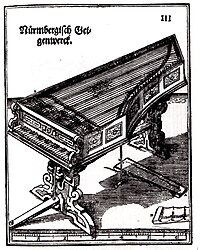The bowed clavier (Bogenclavier, Streichklavier or Geigenwerk in German) is a keyboard instrument strung with gut strings, the tone of which is produced by a steadily revolving, well rosined cylinder powered by a foot pedal, a mechanism similar to that found in the hurdy-gurdy. [1]
The Geigenwerck was illustrated and described by Michael Praetorius in his treatise on musical instruments Syntagma Musicum II, in the section De Organograhia, published 1614-20 in Germany.
It was re-invented by Joh. Hohlfeld of Berlin in 1751. This instrument and another one of his inventions, a device that recorded keyboard improvisations in real time, were mentioned in the " Essay on the True Art of Playing Keyboard Instruments" by C. P. E. Bach.
Another version was the klawiolin, designed by the Polish musician and painter Jan Jarmusiewicz (1781-1844). It was a hump-backed piano with gut strings and a mechanism controlling small bows which could imitate a string quartet. [2]
See also
References
- ^ Dolmetsch Online
- ^ Irena Poniatowska (2001). "Jarmusiewicz, Jan". Grove Music Online (8th ed.). Oxford University Press. ISBN 978-1-56159-263-0.
"Essay on the True Art of Playing Keyboard Instruments", Section Two, W. W. Norton & Company (November 1948) ISBN 0-393-09716-1

